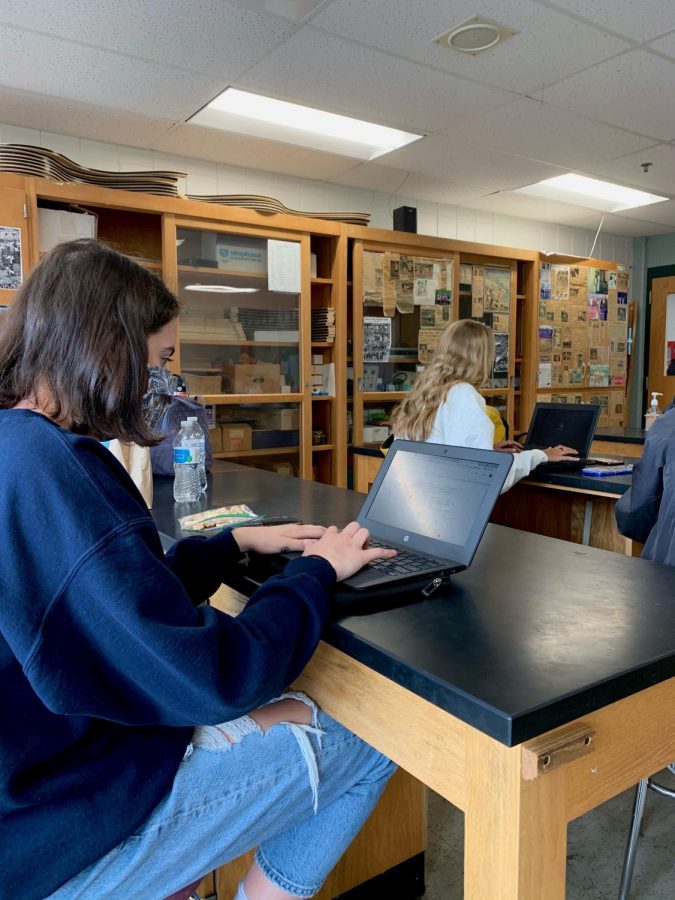The struggles with remote and hybrid learning
May 3, 2021
It’s a Monday morning and a student tries to log onto her online class for remote learning. Her Wifi is acting up and she is unable to enter the class for several minutes. Once in class, she is behind and confused about what the teacher is talking about. While trying to listen to the teacher, her dog is barking in the room over and her phone is blowing up with Snapchat notifications. On top of this, the student has been feeling extra anxious because of online school.
This environment does not seem like the best for a student to be learning in, but it is a reality for a majority of students who have been in remote learning since last March.
Our school systems have been altered by the effects of the Covid pandemic. Forced to teach and learn from their home offices, dining rooms, and bedrooms, teachers and students had to adjust to the technology and routine that was necessary for remote learning. For many, this new adjustment was a struggle that came with many obstacles such as bad Wifi, noisy families in the background, and lack of motivation from behind the screen. There are also reports of health issues related to remote learning that many people had to face in these long months stuck behind a screen.
The technology aspect is most difficult for young children and older adults because of their lack of experience with it. These difficulties weaken the quality of learning and teaching that comes out of remote learning. For others, the transition to remote learning wasn’t too bad because of their knowledge about technology, but this doesn’t mean they still didn’t face obstacles along the way. Now as the pandemic seems to settle down, students and teachers are being allowed to enter school again. This is a great thing for everybody because of all the struggles that come along with remote learning. Students should attend in-person school and avoid remote learning as soon as they can because of the harm and lack of enriching education that they are receiving from remote learning.
Ever since the beginning of remote learning, the quality of education has decreased greatly. There are many factors that contribute to this deterioration, which could easily be fixed once students are back in the classroom. One reason for this is that all of this is new and everyone must learn to adjust to the new challenges that technology brings. Teachers and administrations did not have a lot of time to adjust their plans to fit an online learning environment at the beginning of remote learning. Many teachers had to do the best they could for the time being because they were not very comfortable with all the new technology that was being introduced to them.
A great number of students have expressed their concerns about their teacher’s lack of time to properly prepare to teach in this new environment. In the New York Times article “Students, Parents, and Teachers Tell Their Stories of Remote Learning” by Amelia Nierenberg, a student explains how she feels about getting thrown into this new learning system. Dominique Sollecito, an 11th grader from Queens, New York, says, “My grades dropped a lot last year during remote learning. I went from having 90s to 70s. I’m not proud of it, but it’s true.” Schools did not have enough time to organize themselves for this.”
This is very relatable among many students, especially high school students. Many students’ grades have dropped, but it is not just the teachers’ unpreparedness that caused this. In-person school is much more engaging because teachers can talk to students directly and make sure that they are focused.
Another junior from Ludlow High School, Jacinda Hewes, explains that “In school she participates more and feels more comfortable asking for help.” One-on-one discussions with teachers are much easier and comfortable for a lot of students when they are present in school because they are more engaging and it is easier for them to focus.
Many students are more distracted and have less motivation while learning from home. There are countless distractions in everyone’s homes including siblings, pets, parents, but the greatest distraction is… you guessed it: cell phones! With a number of apps, notifications, and games sitting right next to them, how could anyone not want to focus their attention there rather than listening to a lecture about World War II or how to graph a quadratic equation. With no one around to take their phones, students are prone to watch a TikTok video or send a snapchat during a lesson.
A junior from Ludlow High School named Chloe Homans spoke about her experience with being distracted while in remote learning. She said, “Remote learning was hard for me because there were a lot of distractions at home so I could never really focus.” This is a common comment from many students who have had to receive an education from home.
Distractions related to cell phones are way less likely to occur in school because students know the consequences of using their phones during class, but at home, these consequences cannot be put into place. In the New York Post article “Online learning could leave kids even more distracted than they already are” by Ian Marcus Corbin, the author discusses the distractions that cell phones cause. Corbin states that “Researchers have found that just having your smartphone within arm’s reach, turned off, diminishes cognitive capacity, its mere presence driving your mind to distraction.” In school when students’ phones are usually in their bags, it is less likely for them to be distracted by them, plus the fear of having their phones taken away lessens the chance of them using their phones during class.
Unreliable internet is also a contributing factor to the decreasing quality of online education. With so many people from one household using the same Wifi, when other jobs require employees to work from home, the Internet can be slow and unreliable. Students may get kicked out of their online sessions because of bad connection and miss an important part of the class. Some students may even have limited to no access to the internet. This is a major problem, which allows for students to fall very behind in school.
All of these factors contribute to the lessening quality of online learning during this pandemic. Students would not face less if not any of the problems inside of a school away from distractions with prepared teachers and good internet.
Remote learning also has an effect on the mental and physical health of students. Research has already been done regarding screen time and how much is healthy. For years parents have been nagging their children and telling them to stop using so much technology and go outside, but now that it is necessary for school priorities have changed. Parents have always said to not use so much technology because it is not good for their children, so how bad is it for students to be staring at a computer screen for the entire school day five days a week plus at night and on the weekends for homework.
In a New York Post article called “‘Remote learning’ is a disaster, and terrible for children” by Bethany Mandel the author explains the negative effects that screen time and remote learning have on students, especially younger children. Mandel declares that “we know that excessive screen time is correlated with higher rates of obesity, shorter attention spans, and a decreased ability to read emotional cues from other people.” These effects are all awful for anyone to go through and this can all happen along with mental health problems stemming from isolation in quarantine.
According to an article from Mile High Psychiatry called “How Remote Learning Affects Mental Health” isolation due to quarantine and remote learning can lead to depression, anxiety, schizophrenia, and dementia. Although it is for the safety of everybody, staying isolated can be difficult for the mental health of not only students, but teachers too. As the number of cases lowers and it becomes safer to be in public places as long as safety precautions are followed, students should definitely go back into school to get the social interaction they need.
Many students miss going to school anyway according to a survey given to 400 students by the New York Times. Many of them discussed “the things they miss about going to school: their friends, teachers, sports, extracurricular activities, even “the loud and crazy lunchroom.”
The school allows for students to be social and interact with many people outside of their family and group of friends. Being stuck at home takes away an important aspect of growing and learning social skills necessary for the real world and causes harmful mental health problems.
Although there are many negative aspects to remote learning, there are a few positive things about it. Obviously, it is for the safety of everyone, so if it is necessary for someone to stay home, they should because their safety is the number one priority. Also, students are able to sleep more and gain energy when having an online schedule.
Ludlow High School junior, Alex Lourenco, states that “Remote learning allows him to sleep for a longer duration of time and truly relax his brain before another long day of school work.” More sleep is definitely a pro of remote learning, but it is not worth all of the detrimental effects that remote learning can have on students.
The world today is always changing and remote learning was just one change that affected so many people recently. As the Covid pandemic begins to dial down and students are able to enter school again it is so important that they do so while following the proper safety precautions. This is so important for the future of the world because this generation needs a quality education to take on whatever the future holds. It is time to get back into a schedule that is better overall for the quality of education that students receive and the mental and physical health of the students.


